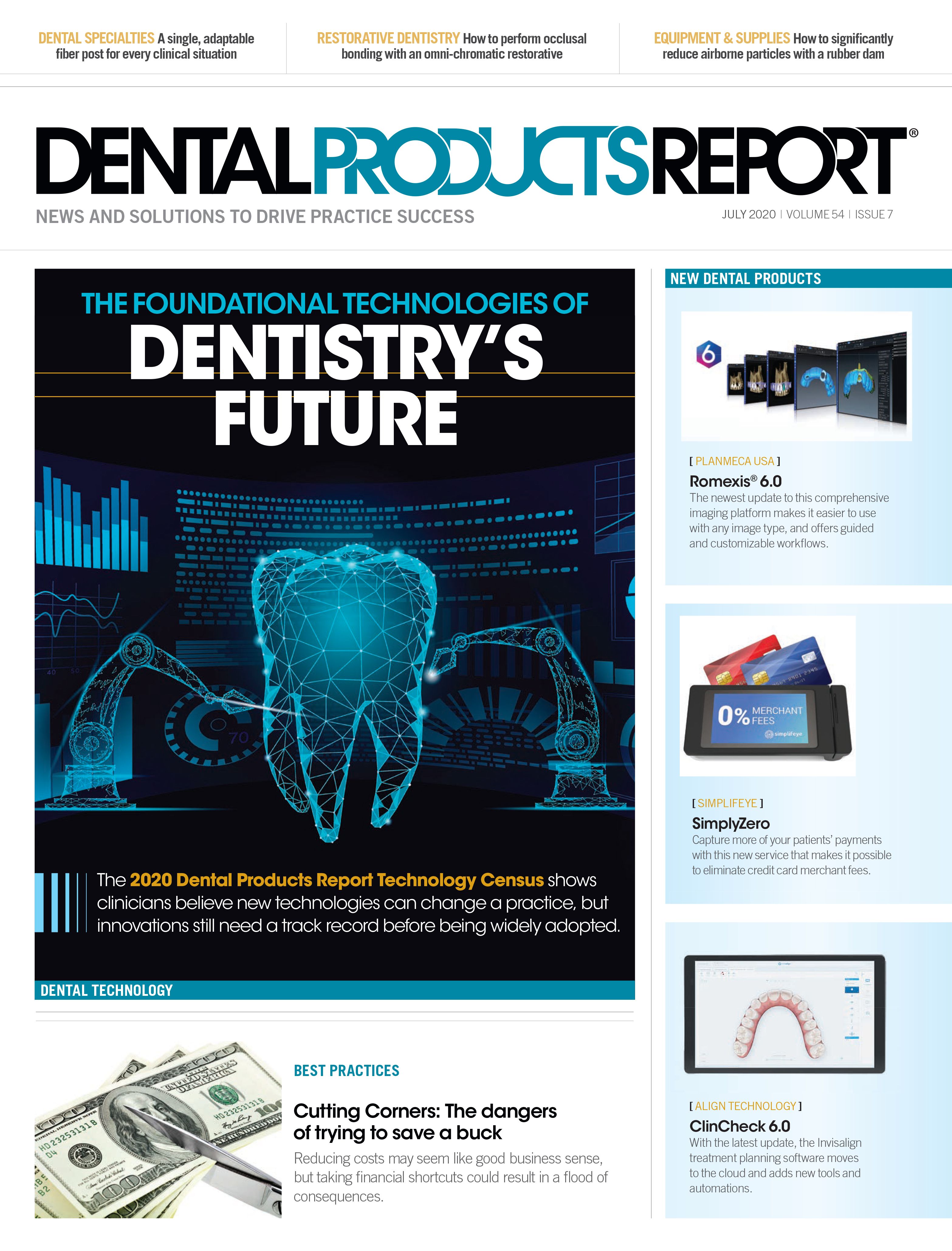The foundational technologies of dentistry’s future
The 2020 Dental Products Report Technology Census shows clinicians believe new technologies can change their practices, but innovations still need a track record before being widely adopted.

Innovation continues to change the ways dental professionals can and do deliver care and manage their businesses. But while there are seemingly endless available possibilities to change the way things are done, the pace at which technologies are adopted by the industry tends to be measured.
With the technology available today, patients can experience care in new ways and with less discomfort than ever before. It’s possible right now for a patient to leave a practice with a new crown without pain or the use of anesthetics with all treatment completed in less than an hour. With cutting edge technology, implant cases can be planned in a completely digital environment, benefit from implant placement guides, and even have a robotic system help to guide the clinician’s hand.
Of course, it’s not just digital CAD/CAM solutions, big ticket lasers and imaging systems, and 3D printers revolutionizing the industry. New software platforms are making it simpler for practices to connect with patients and for patients to interact with practices, while also employing artificial intelligence to smartly automate common tasks. Dental materials are also benefiting from technological advancements all the time, as new generations and new formulations bring a range of new benefits during and after treatment to both clinicians and patients.
To get a sense of how all of these innovative products and services are being adopted throughout the industry, Dental Products Report conducted the 2020 Technology Census earlier this year. The data from this survey is presented in the tables and charts on the following pages.
The overall message from the survey is dental professionals are excited by the technologies making their way to their practices. However, the hype around new things fades quickly as dental professionals say they are more likely to invest in new technologies when there is a solid track record of research and clinical success.
Read on for the results of the 2020 DPR Technology Census and a look back at how these latest numbers compare to the 2010 DPR Technology Census.
Experience with dental technologies
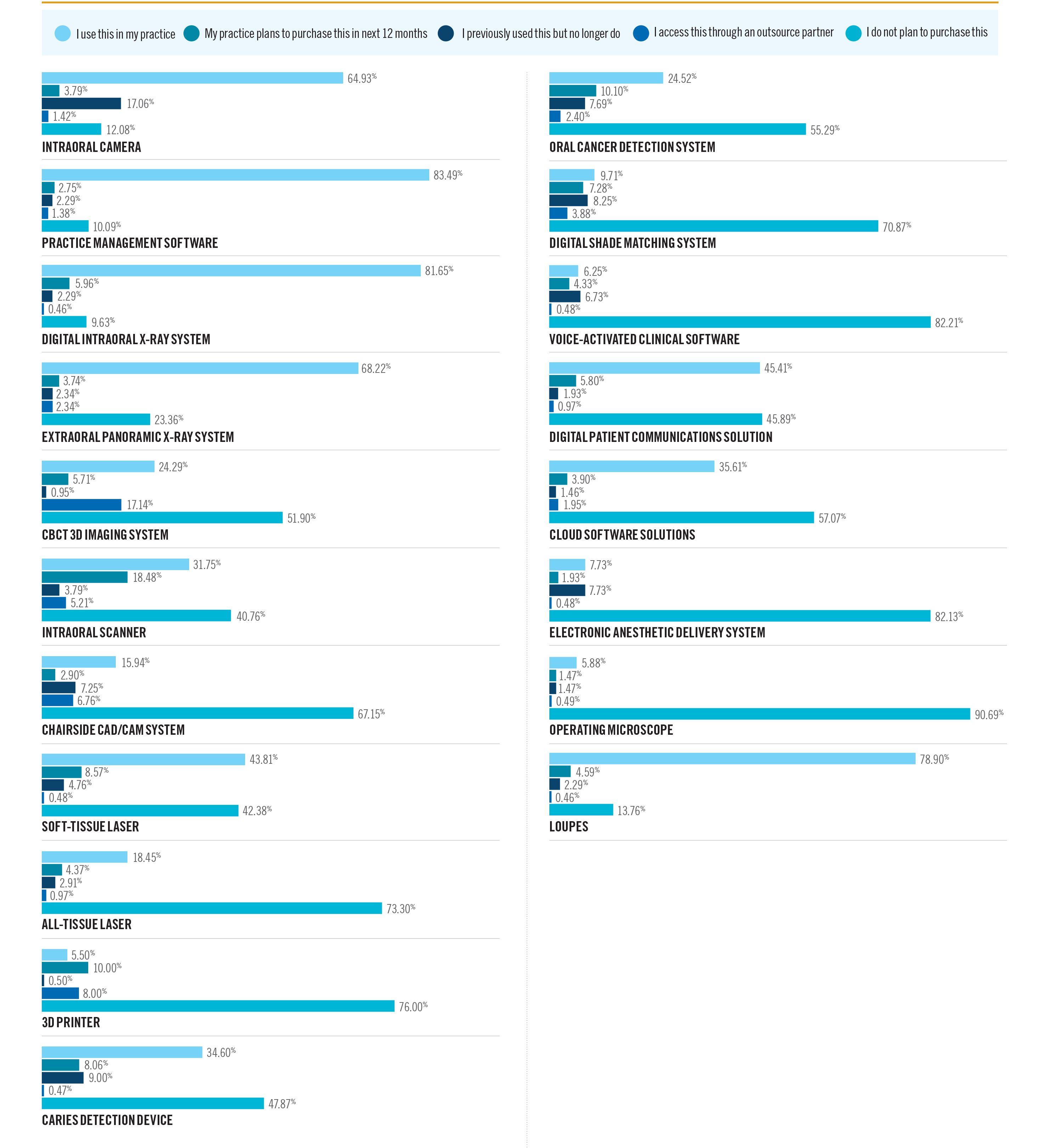
What you use, what you want, what you no longer want
When it comes to technology adoption, a lot has changed in the past 10 years, but not everything. In 2010, 64% of clinicians said they used an intraoral camera, and in 2020 that number is 65%. However, 17% of 2020 respondents said they’ve used an intraoral camera but no longer do. In 2010, 58% of practices used digital X-rays and an additional 21% said they planned to purchase X-ray sensors soon. In 2020, 82% of practices are using digital X-rays and another 6% plan to purchase them soon.
Two areas of tech adoption over the past 10 years are cone beam and intraoral scanners. In 2010, 7% of practices had cone beam and another 7% were planning to add them, while 12% had intraoral scanners and another 12% were planning to adopt them. This year the Technology Census finds 24% of practices have cone beam with another 6% planning to purchase. Another 17% use an outside partner for 3D imaging. Intraoral scanner adoption is growing even faster. 32% of practices now use the technology and another 18% plan to go digital in the next 12 months, the highest percentage for any technology in the survey.
On the other hand, not every technology seems to be in demand right now. More than two-thirds of clinicians said they do not plan to invest in chairside CAD/CAM, all-tissue lasers, 3D printers, digital shade matching technology, voice-activated software, electronic anesthesia delivery systems, or operating microscopes.
Can these technologies provide a strong return on investment?
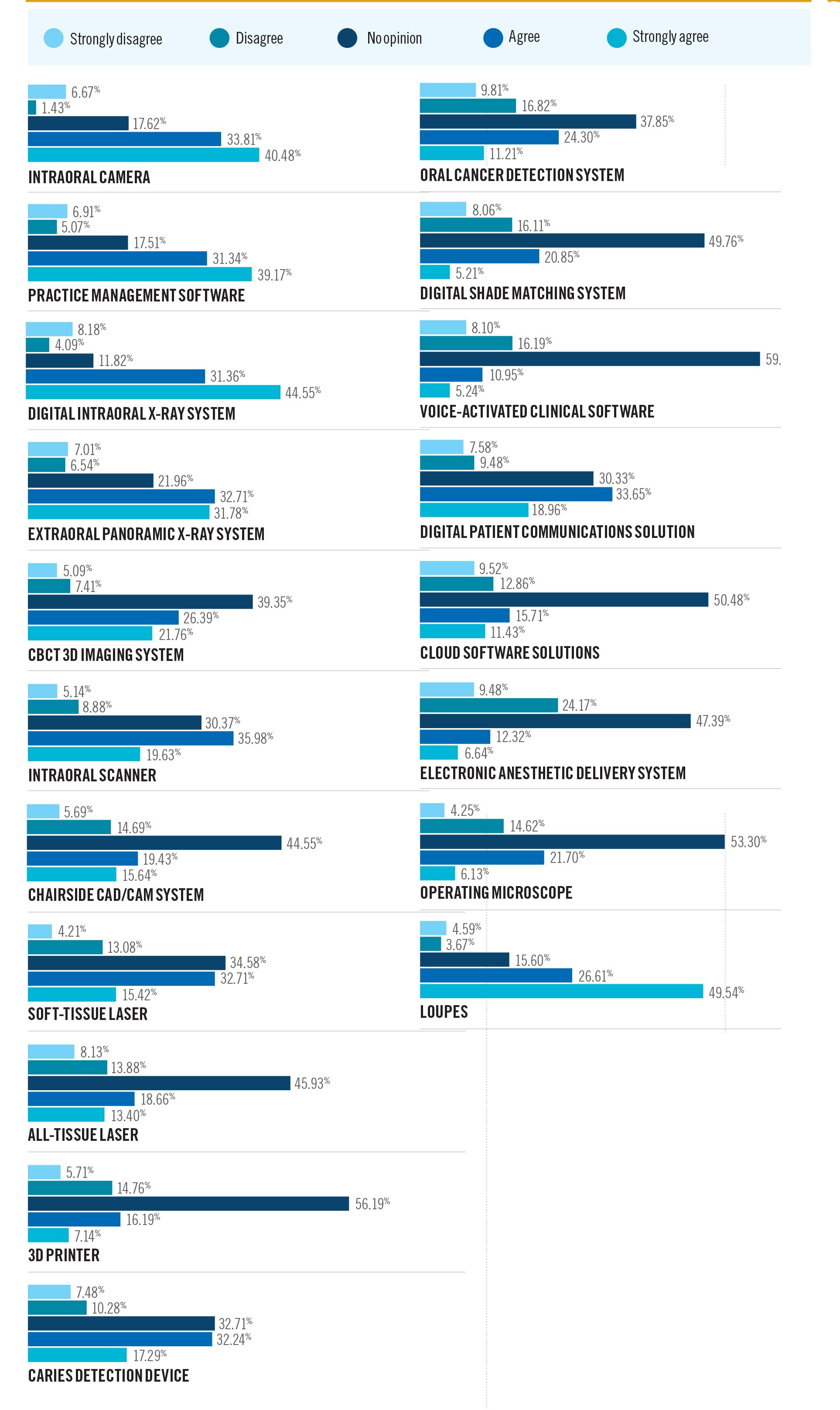
Tech ready to earn its keep
While the clinical efficacy and benefits of any new technology are paramount, dental practices are businesses, and technology investments need to be financially beneficial as well. When asked about the ROI potential of different dental products, clinicians showed a belief in the potential of digital imaging technologies to benefit a practices’ bottom line. Intraoral cameras and digital X-ray systems were both strongly touted by more than two-thirds of respondents. The only other technology to score that high when it comes to ROI was dental loupes. Clinicians showed doubt about the ROI potential of other product types, with electronic anesthesia delivery leading the way, and cloud software, voice-activated software, digital shade matching, oral cancer detection, 3D printers, all-tissue lasers, and chairside CAD/CAM all earning the skepticism of more than a fifth of clinicians.
Can this technology make a big impression on patients and drive word of mouth referrals?

Technologies that get noticed
When it comes to impressing patients and driving referrals based on a practice’s technology, digital dentistry earns high marks. More than half the clinicians who took part in the 2020 Technology Census believe patients are impressed by panoramic and cone beam systems, intraoral scanners and full chairside CAD/CAM, soft-tissue lasers, digital patient communications, and loupes. However, intraoral cameras and digital X-rays are the only two categories where more than two thirds of respondents see the potential to impress patients. On the flip side, no technology came up as unimpressive to more than half the respondents, and only practice management software was cited as unimpressive to patients by more than a third of clinicians.
How would you describe yourself in terms of incorporating new technologies into your practice?

Your Dental Tech Self Reflection
When asked to describe themselves when it comes to investing in new technologies, a majority of dentists consider themselves a researcher, looking for clinical studies and hands-on demonstrations before investing. However, the number of dentists saying this dropped by 10% in the past decade. In 2020 54% of dentists described themselves as Researchers, but in 2010 that total was 64%. The 27% of dentists describing themselves as ROI fanatics remained the same over the past decade, but the percentage of dentists who consider themselves impulse shoppers increased by 2% to 6% in the 2020 Technology Census, and the number of clinicians saying they like to look but not buy new technologies jumped from 5% in the 2010 Technology Census to 13% this year.
What emerging technology has the biggest potential to impact dentistry’s future?
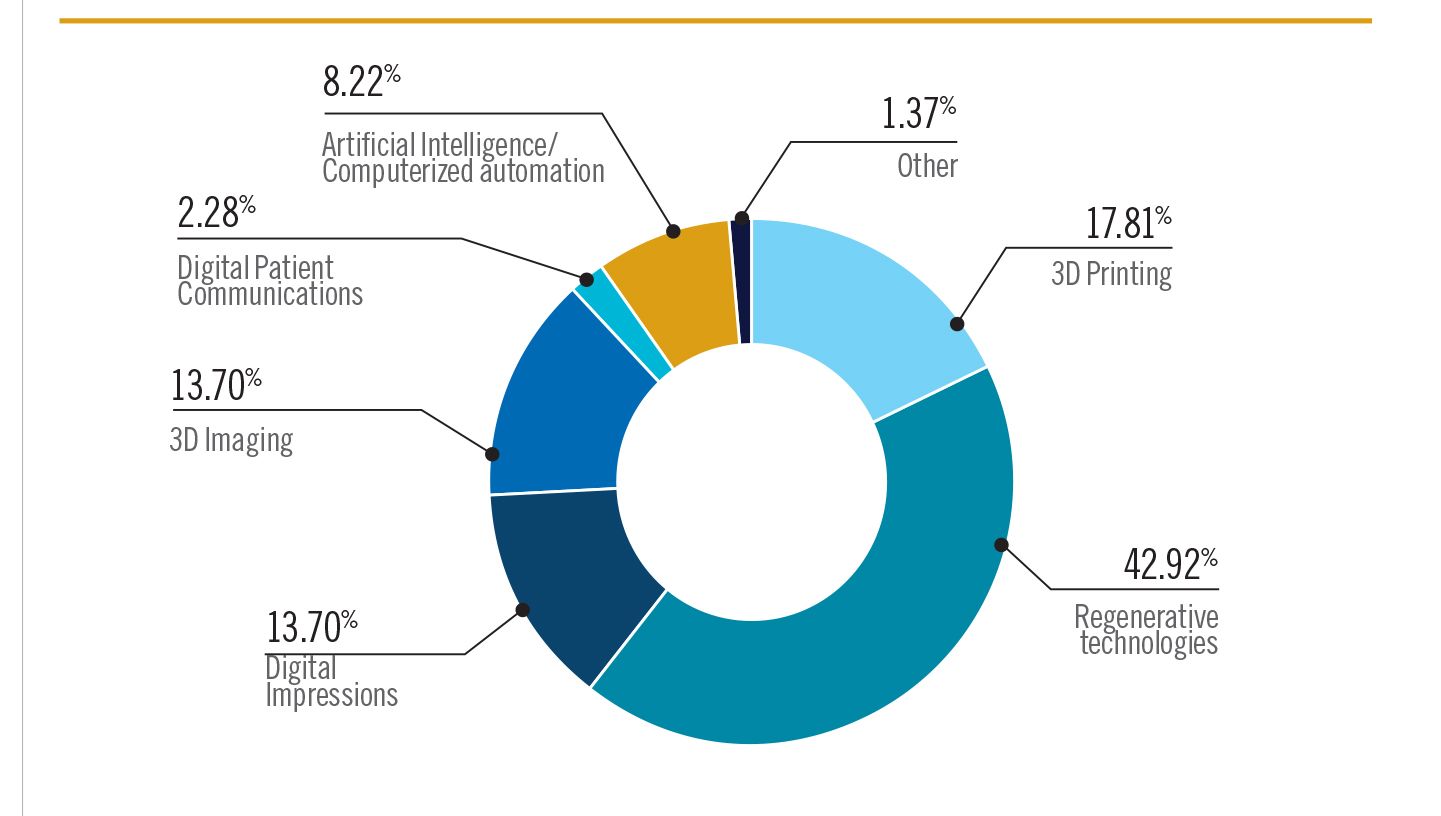
The tech set to change the game
When it comes to the future of dentistry, the results of the 2020 Technology Census show machines might not be the way forward. While many technologies have already changed the industry, and many more are in the process of changing how dentists work and how patients experience their dental visits, the technology dentists see the most revolutionary potential in might not run on electricity or feature artificial intelligence. Instead, 43% of respondents said they see regenerative dental technologies as the most exciting concept on the horizon. The ability to regrow teeth and other damaged structures would certainly change the way most practices operate. 3D printing was the next most popular answer with 18% of clinicians seeing potential there.
Does this technology offer little value to the dentist or the patient?
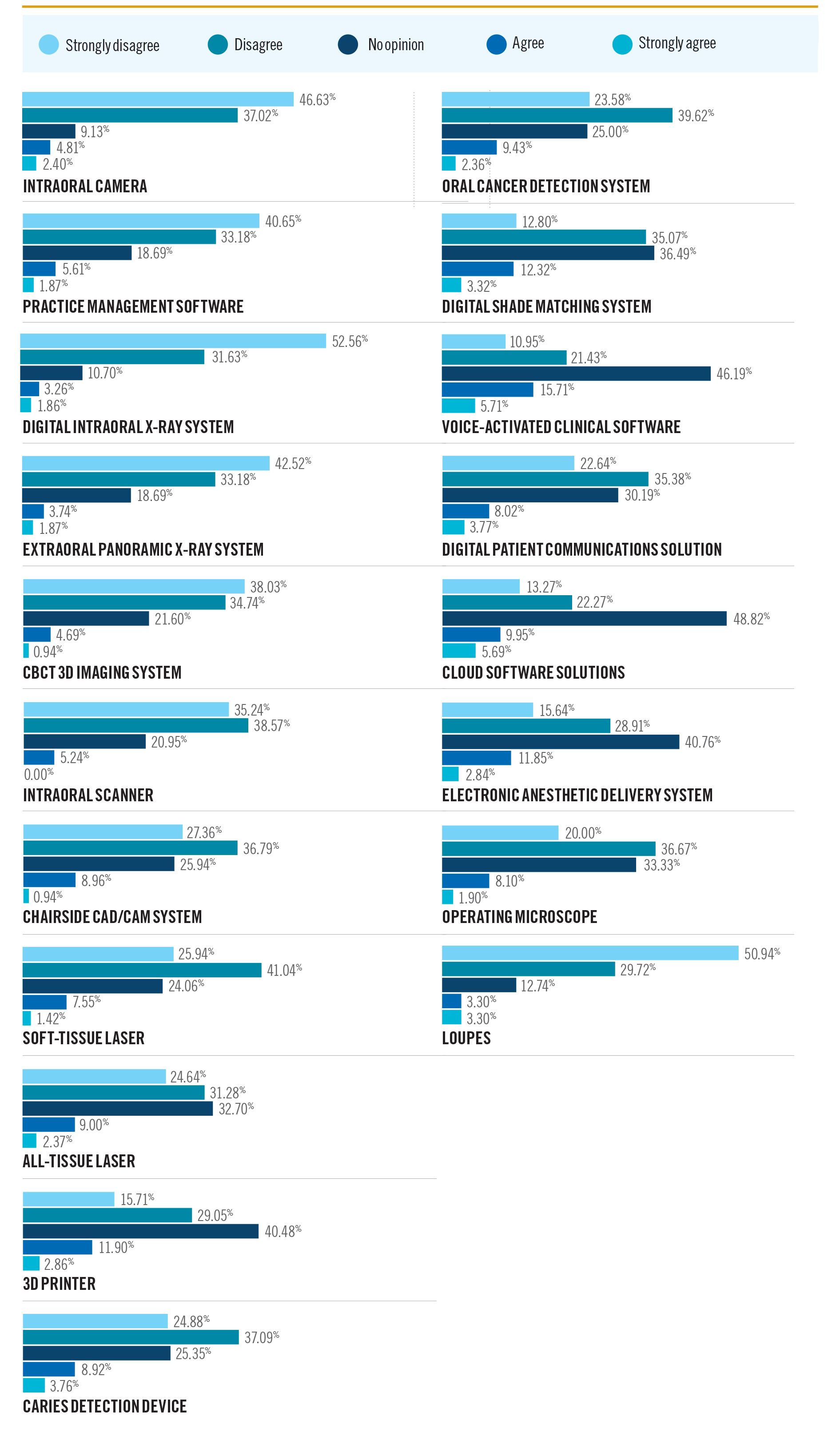
The most valuable technologies
When asked to rate the technologies that did not offer benefits to practices or patients, no technology stands out. While 22% of clinicians said they find no real value in voice-activated software, that was by far the highest total, and in most cases more than two-thirds of clinicians can see the value to the practice and/or patients from the industry’s technologies, even if they are not planning to invest in those technologies themselves.
